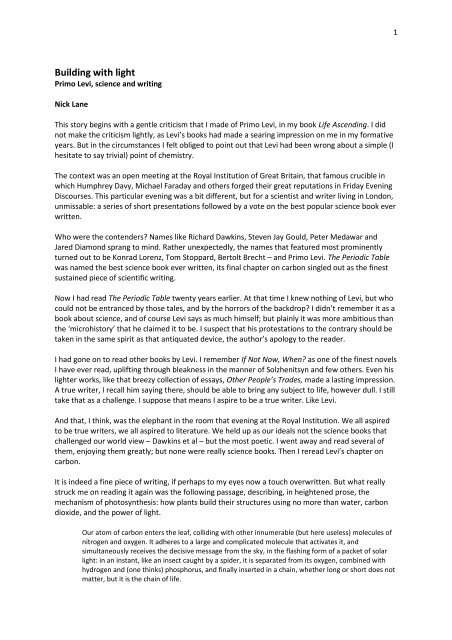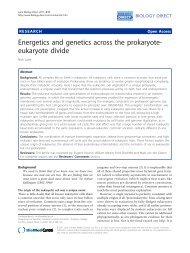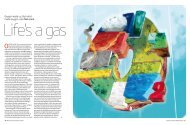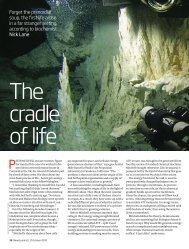Building with light - Nick Lane
Building with light - Nick Lane
Building with light - Nick Lane
- No tags were found...
You also want an ePaper? Increase the reach of your titles
YUMPU automatically turns print PDFs into web optimized ePapers that Google loves.
4Such experiments are how we know what little we do know; and that knowledge, that insight intomechanism, is the glory of biochemistry. It is also our surest guide back into the depths of geologyand time. A final irony relating to Primo Levi lies buried there.Rocks and life may seem diametrically opposed: the inanimate versus the animate, the unyieldingagainst the yielding. Yet many rocks are formed by life itself, often on a fantastic scale, and not justlimestones and chalks formed from the shells of sea creatures. Take iron. Great mountains, indeedwhole ranges like the Hammersley Range in Australia, are composed of ‘banded iron formations’,the most abundant low-grade iron ore deposits in the world. Levi could not have known this, as theculprits were not discovered until the 1990s, but these mountains are in all likelihood deposited byanother type of photosynthetic bacteria plying their trade.Back then, three billion years ago, bacteria were only just beginning to split water: that is a difficultand dangerous trade. Most bacteria chose easier targets, notably hydrogen sulphide – and iron.Before the rise of oxygen, ferrous iron dissolved freely in the oceans of an anoxic world. There were(in time) literally mountains of it. These bacteria stripped this ferrous iron of electrons, and strippedprotons from water itself, and combined them into hydrogen. The waste was rusty rock – ferric ironhydroxides and oxides. These settled to the bottom of the oceans on a colossal scale, heavy enough,I am told, to plunge deep into the mantle of the Earth. A small proportion was thrust back up to thesurface by tectonic forces, there to be mined by others plying their trade. It is a story, I imagine, thatLevi would have cherished.There is one other: a story of rock giving birth to life. On re-reading The Periodic Table, this must bethe deepest irony of them all. Primo Levi’s first job, on graduating in Chemistry in 1941, cum Laude,but as a member of the Jewish race losing his entitlement to work, was in a mine in the serpentinefoothills of the Alps. His task was to isolate and enrich the small quantity of nickel from the iron and(one thinks) magnesium. Despite some joy in this ancient human trade, he at times grew frustrated<strong>with</strong> the lifeless obduracy of the rock:At moments of weariness I perceived the rock that encircled me, the green serpentine of the Alpinefoothills, in all its sidereal, hostile, extraneous hardness: in comparison, the trees of the valley, by nowalready dressed for spring, were like us, also people who do not speak but feel the heat and the frost,enjoy and suffer, are born and die, fling out the pollen <strong>with</strong> the wind, obscurely follow the sun in itstravels. Not the rock: it does not house any energy, it is extinguished since primordial times, purehostile passivity…I know a geologist: a brilliant, argumentative, erudite scientific prophet, once a rough boy from EastLondon, who started out on his career as an industrial chemist, working on nickel too. He became adistinguished mineral geologist, famed for his work on the same mineral lodes, rich in nickel or goldor pyrites, that entranced Primo Levi. Some were formed, he said, in the deep ocean hydrothermalvents. And then he metamorphosed into something else. He became obsessed <strong>with</strong> the origin of life,for he saw that life, too, began <strong>with</strong> the geochemistry of submarine vents.Not just any geochemistry, but the reaction of water <strong>with</strong> rock: <strong>with</strong> the mother of serpentine, themineral olivine. The rocks of the ocean floor, thrust up from the mantle below, fizz and crack <strong>with</strong>the embrace of water. They give up hydrogen gas, the mother of life itself, now free to react <strong>with</strong>carbon dioxide, no need for the energy of the sun. This rock is full of catalysts, found today in thevery cells that dwell <strong>with</strong>in the crevices. Among them, tightly bound up to iron, is nickel, the ‘littledemon’ that is also the catalyst of life.
If Mike Russell is right – I say why I think he is in Life Ascending – then this hostile rock did indeedgive up its energy in primordial times, <strong>with</strong> the release of hydrogen. How pleasing that Primo Levitried to tease the nickel out by pumping hydrogen back in. It’s hardly surprising it didn’t work. Hishostile rock was dead because it had already given birth to life.5





